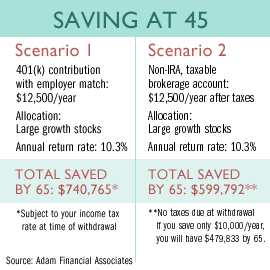|
Midlife savings crisis 101
|
 |
January 28, 2000: 3:16 a.m. ET
Boomers with careers and kids shouldn't postpone retirement planning
By Staff Writer Jeanne Sahadi
|
NEW YORK (CNNfn) - You're in your mid-40s, your kids and job stretch you like a piece of taffy, and whenever someone mentions "retiring" all you can think of is sleep. Long-term savings is the last thing on your mind.
Who can blame you? After paying your mortgage, taxes, car loans, credit cards, groceries, utilities, house repairs, vacations and daycare, it's tough to find money to set aside for tomorrow.
But beware. You could find yourself scrambling for cash during your retirement years ... unless you take action now.
Get a grip on your dollars
Before you make any savings decisions, experts recommend you figure out how much money you spend every year and where it goes.
You may not be as squeezed for cash as you thought.

Mari Adam, a certified financial planner in Florida, once worked with a couple who assumed they didn't have much money to set aside. They had two teenagers and an annual income of $150,000. But when they catalogued their expenses, they were shocked to find they paid $5,000 for hockey tickets and could not account for another $35,000.
Prioritize, then maximize
Once you see what you spend your money on, the next step is to decide what's most important to you and cut back on the rest, freeing up some money for long-term investing.
The most painless retirement savings plan is one that lets you use pre-tax dollars. "If you can't touch it, you can't spend it," said Ellen Breslow, Salomon Smith Barney's director of individual retirement planning.
So if you have a 401(k) plan at work, defer as much as you can and take advantage of any matching employer contribution.

Even if your deferral is less than the maximum allowed, it might lower your tax bracket and will get you in the habit of saving regularly.
"The most important thing in investing is compounding over time," Adam said. "Start small, but start now."
To further reduce your taxes and expenses, Adam suggests using any flexible spending programs at work. They let you deduct pre-tax money from your paycheck to help pay for medical costs and child care.
But what about the kids' tuition?
Many parents who put off saving for retirement are bracing for a much more immediate obligation: paying for their children's college educations.
As daunting as that is, experts say don't put your retirement needs on the backburner.
"You should balance the needs," Breslow said. "Time is working against you."
Compounding is key to building your nest egg, and your timeline will be much shorter if you wait until the kids graduate to start getting serious about retirement, she warned.
One solution if you feel torn is to divide your maximum 401(k) contribution, putting half in your retirement fund and half in your children's education funds.
Breslow and others recommend qualified state tuition plans, which let your gains grow tax-deferred until your kids go to college. The earnings then will be taxed as income to them -- at a much lower bracket than yours.
Profit from post-tax dollars
To further boost your retirement income, Adams advocates putting some after-tax dollars into a low-cost automatic savings plan with places like Schwab, Vanguard, T. Rowe Price or Janus.
Based on an amount you choose, the brokerage or fund house regularly deducts money from your paycheck or checking account and invests it in a fund of your choice.
If you want diversification but don't want to pick the funds yourself, invest in a "fund of funds." They invest in other mutual funds, giving you exposure to a variety of strategies, and are geared toward novices looking for one-stop shopping.
Or, consider a fund whose allocation strategy is based on your approximate retirement year - for example, the Fidelity Freedom 2020 Fund. The investments become increasingly conservative as your target date nears.
Lastly, if you are eligible for a Roth IRA, Adam and others suggest you contribute up to the $2,000 after-tax limit.
Know thyself and forget the Joneses
Whatever your circumstance, sticking to a serious retirement savings program will be tough unless you know your financial personality.
"There's a psychological component to all this," certified financial planner Christopher Cordaro said.
Experts recommend you get rid of credit card debt before putting money into a retirement account.
"That makes the most dollars and sense," Cordaro said.

But if you are a compulsive spender who will max out your credit as soon as you clear your account, start saving now.
Of course, the pressures of a consumer society don't help. Part of what drives people to spend money instead of save is a desire to impress others.
But, Adam said, "if you try to keep up with the neighbors, you'll have a tough time. Something's got to give." 
|
|
|
|
|
 |

|

